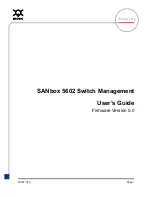
®
ServSwitch CX Uno features - front and rear
The ServSwitch CX Uno units pack a great deal of functionality into a compact
space. Both models occupy half of a single 1U rack space and provide most of
their connectors at the rear face. The smart front face features the remote user
link port and the operation indicators.
INDOOR
USE
ONL
Y
5V
2.0A
4
12
3
11
2
10
1
9
8
16
7
15
6
14
5
13
OPTIONS
COMPUTER CONNECTIONS
COMPUTER CONNECTIONS
LOC REM OSD UPG LCK PWR
BLACK BOX
CX Uno
BLACK BOX
724-746-5500
®
®
KVM
only
Options port
This RS232 serial port can separately support the following functions:
• Power switching - can be configured to control multiple power switching devices.
• Remote control switching - commands can be received that will change the
channel, as necessary.
• Synchronization - allows the actions of two or more ServSwitch CX Uno switches
to be synchronized so that multiple computers/video screens can be switched and
accessed.
• Upgrades - used to update the internal firmware when necessary by connecting to
a computer.
• Transferring configuration settings - allows information about the connected
computers to be saved and restored.
Local user port
Connect a USB keyboard and mouse, plus a video
monitor and optional speakers to these connectors.
These allow you to perform the initial configuration
of the ServSwitch CX Uno. Additionally, you can use
these to locally control the connected computer(s).
Computer ports
Each computer connects to one of these ports via
standard category 5, 5e or 6 cabling. At the other
end of the cabling a SAM (Server Access Module)
is used to provide the necessary keyboard, video,
mouse and optional speaker connections.
Power input
The power supply
connects here.
Remote user port
This port can either be used to connect a single
remote user (with an optional CX R or CX R
USB extender module) at a distance of up to
300m or used to connect other ServSwitch CX
Uno units in cascade.
IMPORTANT:
This is not an Ethernet port and
must not be connected to any network.
Indicators
These six indicators clearly show the key aspects of operation:
•
LOC
Keyboard or mouse data are being received from the local console.
•
REM
Keyboard or mouse data are being received from the remote console.
•
OSD
Indicates that the on screen display is currently active.
•
UPG
Indicates that the unit is currently in upgrade mode.
•
LCK
Security mode enabled and no user logged in.
•
PWR
Power input indicator.






































